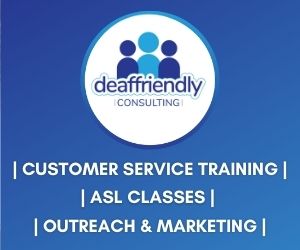8 Realities of Accessibility Tax Credits and Deductions - Through a Deaf CPA’s Eyes
Posted by: Staff Writer on June 17, 2013

Ever wondered why, in the enlightened 21st Century, it still seems so gosh-dang impossible to coax some businesses to invest in your basic right to services like sign language interpreters or CART? We wondered the same, so we asked Howard Knight, a deaf CPA and Principal of Howard Knight, CPA, to give us the straight scoop about the realities of accessibility-oriented tax credits and deductions.
“Building accessibility and codes are much more of a concern for many brick and mortar type of businesses than trying to please a potential customer who asks for an interpreter,” the Texas-based accounting expert said. “I’ve heard of ridiculous lawsuits filed just because the toilet roll was installed at the incorrect height, but not for bad customer service.”
This brings us to the first of many tax realities:
Reality #1: Businesses prioritize infrastructure over service-based accommodations
To encourage small businesses to be ADA-compliant, the Internal Revenue Service (IRS) Code includes a Disabled Access Credit (Section 44) for businesses with 30 or fewer full-time employees or with total revenues of $1 million or less in the previous tax year. But out of the millions of businesses in America, how many actually take advantage, and of which tax incentives?
While the max deduction for Architectural/Transportation tax deduction (such as widening doors or building ramps) is $15,000 and applies to businesses of ALL sizes, the small business tax credit (Disabled Access Credit Form 8826) is only 50% between $250 and $10,250 (Max = $5,000).
But is it really about money, or are small businesses in over their heads with the paperwork required?
“We are talking at least four pages of tax forms to go through and it would take a novice in a small business at least six hours of record keeping and preparation just for this tax credit,” explained Knight. “It could take at least three days of work for a corporate bureaucrat plus several weekly meetings with management to get this nailed down.”
Likewise, the Work Opportunity Credit (Form 5884) which encourages employers to hire targeted groups like SSI recipients and vocational rehab referrals maxes out at $2,400 per year.
Reality #2: Even with deductions and credits, "we have bigger fish to fry" mentality persists
To put this into perspective, think big. Like, Fortune 500 big. Facebook was valued at $50B by early January. While that appears to mean big companies have deep pockets to invest in things like sustainability and accessibility incentives, it's a Catch-22:
"A $50 billion corporation isn't going to be very excited to hear about another small tax credit," said Knight, who has worked 12 years in a corporate setting. "Sure, $5,000 sounds like a lot for an individual but even where I've saved over $291,000 a year at corporate it still doesn't impress more than three or four working people around me. That was 0.00007% of the budget.”
(Jeff Bezos, the famously frugal CEO of Amazon.com, just might be one of those types).
Reality #3: Small businesses are “hit or miss” with ASL interpreter requests
With big businesses, one can expect they are ahead in the accessibility game. So what about the small businesses - the ones deaf/hh Americans have to do the most smooth-talking, requesting, and negotiating for interpreting, note taking, or CART accommodations?
To tug at a small business owner's purse strings, you often need to also tug at their heart strings ... or make a good case for why it's worth the effort.
Wooing the “mom and pop” system is as much about social skill as it is pure mathematics. Perhaps as a result of lifetime conditioning, some of us take anything but a vociferous approach: “We don't want to be a burden on small businesses either, so we would have to approach this very gently if we really want to use their specialized services (like nutrition consultants, doctors in private practice, etc.),” added Knight.
Reality #4: Disabled Access, Work Opportunity Credit Only Used By Small Number of Tax Filers
Instead of large corporations that Knight frequently works with, it really is individuals who make use of the Disabled Access Credit and Work Opportunity Credit. These individuals, ranging from graduate students to "corporate executives with nannies and vacation homes," are becoming farther and fewer in between, Knight said.
“I have not come across any clients in a while where I’ve seen an opportunity to take the Disabled Access or Work Opportunity Credit. Mainly because these credits are usually in growing businesses.”
Takeaway: Businesses, take note: Are you (or your CPAs/CFOs) missing out on these accessibility credits/deductions?
Reality #5: Businesses are busy ... and not always informed about the myriad of credits and deductions available
Despite the ADA being over two decades old, it's still a pile of hazy fine print to many business owners. Same for the IRS tax code (which is hundreds of pages long). Combine the two – as well as human nature - and sometimes businesses miss out on these tax opportunities entirely.
“It's unlikely that a sole proprietor dentist, for instance, is going to stop working to Google if there is a tax deduction for hiring an ASL interpreter,” said Knight. “Easier for them to slam the phone as bad customer service than to mess with more paperwork and billable hours for tax advisory, and that's a sad fact,” Knight said.
Takeaway: As the saying goes - The customer is king. Businesses, are you overlooking the hundreds and thousands of dollars in potential repeat business from deaf/hh patrons (and their friends)?
Reality #6: Was your accommodation request rejected? Stand up for your rights, but don't take it personally either
“It’s not intentional to ignore the potential tax credits to help provide access and accommodations for deaf people. I believe most people even at corporate or struggling small businesses have a kind heart to make the world a better place. But at the same time, many people are under pressure with so many priorities and too much information swirling in their heads that adding one more thought is just about to reach their breaking point.”
Takeaway: So, what can you do when this happens? Play to the numbers-oriented mindset of the business. Build a case for yourself and briefly mention tax incentives (use our Tax Credits and Deductions Available to Businesses link if you write an email) as well as alternatives to an accommodation that may present “undue financial burden.” Example: Would hiring a non-certified interpreter be sufficient for the particular appointment? Can you get a large group of deaf friends to buy tickets to the cash-strapped local theater play, to help justify the cost in their minds?
Reality #7: “Save (a little) now, pay (a lot) later” is a bad long-term tax strategy
Times are tough, and it's tempting to save by skimping on professional tax advice (the cost of which can make tax season even more of a tug on the purse strings than it already is). That can be a recipe for disaster:
“What worries me the most is when people don't take my tax advice or try to do something frustratingly complicated by themselves just to save a few hundred dollars,” said Knight.
Even if that doesn't directly result in the black-suited IRS agent pounding on your door for an audit, it can add up to a lot of grief later. Classic example: Cashing out early on 401k investments before age 59 ½ (this triggers a 10% early withdrawal penalty, not to mention higher marginal tax on it).
Reality #8: Despite all these “reality checks,” there's no excuse not to make a full range of deaf-friendly accommodations a reality
According to the “ADA Update: A Primer for Small Businesses”, the demographics of disabilities is anything but small:
“More than 50 million Americans – 18% of our population – have disabilities, and each is a potential customer. People with disabilities are living more independently and participating more actively in their communities. They and their families want to patronize businesses that welcome customers with disabilities.”
Clearly, taxes have a long way to go to meet the demographic demand. Maybe it's a top-down process, requiring our lawmakers to redefine its accessibility incentives. Or maybe it's a bottom-up process, with organic hand-holding, education, and of course, writing consumer reviews. Rome wasn't built in a day, and neither will businesses that are fully cognizant about deaf-friendly decisions (and the tax incentives resulting from them).
Businesses, ready to jump-start your customer service and get a tax boost too? For a cheat sheet, check out deafREVIEW's Tax Credits and Deductions Available to Businesses. Your patrons will thank you for it.
 .
.
BIO: Howard Knight is a certified public accountant who provides accounting, tax and financial services for business and individuals. His firm, based in Houston, Texas is committed to fostering long-term relationships with his customers nationwide. His contact information can be found here.
.
Tags
- deaf
- hard of hearing
- deaf culture
- sign language
- deaf-friendly businesses
- deaf community
- hearing loss
- consumers
- ada
- irs
- tax deductions and credits
- cart
- sign language interpreter
- howard knight
- deaf cpa
- texas
- disabled access credit
- work opportunity credit
- ssi
- fortune 500
- jeff bezos




Comments